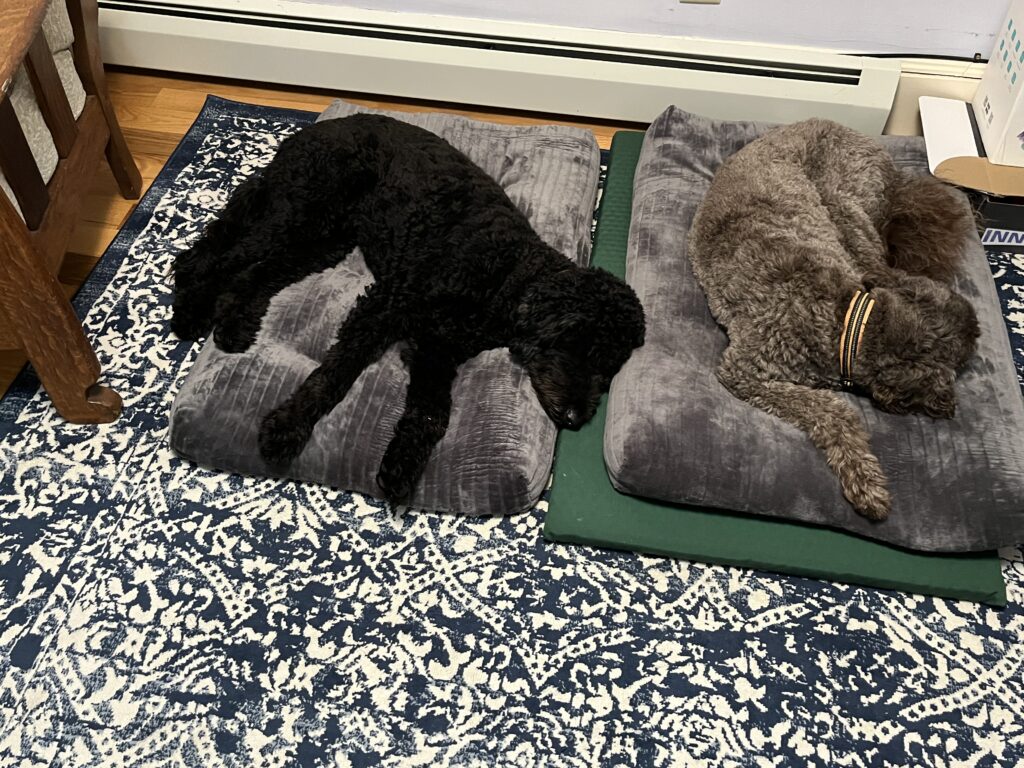
Dog Charmer Tom by Tom Shelby
The Dog Meet:
Energetic Youngster Jeffrey and
Senior Paula Jean are Doing Just Fine
Dear Readers (and me),
Having had Paula Jean—the easiest dog in the world to live with—for the last nine years, I feel I should not only remind myself of what to do when bringing a new, punk age, 9-month-old dog into the home with an 11-year-old totally cooperative, placid poodle, but I should also share some of the do’s and don’ts.
First thing is the “meet.” Dogs are territorial, some a lot more than others. So, if you want to introduce two dogs in the hope of their getting along, best do it on neutral territory as opposed to bringing one dog to another’s house. If it must be at another’s house, have the “meet” outdoors. In this case, I felt okay about bringing PJ to Jeffrey’s house because of his youth, and I wanted to know right away if he’d surprise me by showing an aggressive, territorial response. Had I brought him to my house first, Paula Jean would have been appalled at the intrusion of this bigger, heavier, ill-mannered brute playfully accosting her in her own den.
The “meet” went fine, with Paula checking out the new smells while trying to ignore Jeffrey, as he was trying to get her attention, totally thrilled at the new presence, but respectful enough. And so it was decided, we would take Jeffrey home after the long weekend which had just begun. Without saying anything, I took two small pieces of cloth and rubbed Jeffrey to capture his scent. I then placed one under Paula’s food bowl and the other under her favorite bed, the idea being to give Paula a positive association with Jeffrey’s scent.
Four days later, wife Jaye, Paula, and I are ushering Jeffrey into the car for his new (all of our new) life with a new family unit. Paula was clearly appalled at this intrusion, but tolerant. Once home, they were both let into my fenced back yard, where Jeffrey had a FRAP (frenetic random activity period), which many people refer to as the “zoomies.” It’s a common energy release. PJ looked on with an air of disgust at the immaturity of this intruder.
In a litter of puppies, it is common for one of the dogs to establish itself as the dominant, or alpha, dog by four months of age, and it’s not often based on size or aggression, but rather “attitude.” It was important to me that PJ have the dominant role in this new family unit, as she would not have been happy to be second fiddle to this young newcomer. So she is greeted first, fed first, petted first, etc. And so far, Jeffrey is duly respectful.
He had been crated at his previous home, so I crated him initially, and then experimented by leaving him free for short periods with Jaye and me gone, with no problems. After about two weeks, the crate was removed. Neither dog is experienced at sharing toys, which is referred to as “resource guarding,” but with my supervision it’s coming along, and is facilitated by the fact that PJ likes soft, plushy toys and Jeffrey likes the hard ones.
For the last half century I’ve been able to walk all my dogs off leash anywhere, with them cooperating when I said, “leave it,” or “come” or “stay.” We hike about two-plus miles on the surrounding woodland trails almost every day, and it started with Jeffrey dragging a four-foot leash with the handle cut off on a harness, running free. He would be called to come multiple times every walk, only to receive a people food treat when he arrived. He’s been “off leash” for the last two weeks, with 100 percent recall cooperation for a tiny dog treat. His “leave it” is excellent. His “stay” is still a work in progress, as I increase the intensity of the distractions that he must ignore and stay put.
When I was actively working 800 training appointments a year, most often the last appointment was what I called the “Door Turmoil Routine,”—the routine at the door to eliminate the turmoil when a visitor arrived. It’s the final training routine because it’s one of the hardest to teach, as dogs are “territorial.” That’s why getting Jeffrey to sit and stay when somebody knocks on the door and is entering is still a “work in progress.” He still takes the position that the visitor at the door is there for him, and it’s his responsibility to fully molest that visitor in his joy at the visitation.
Bottom line, his new presence is an absolute joy; challenging but, none the less, wonderful.
Dog Charmer Tom

